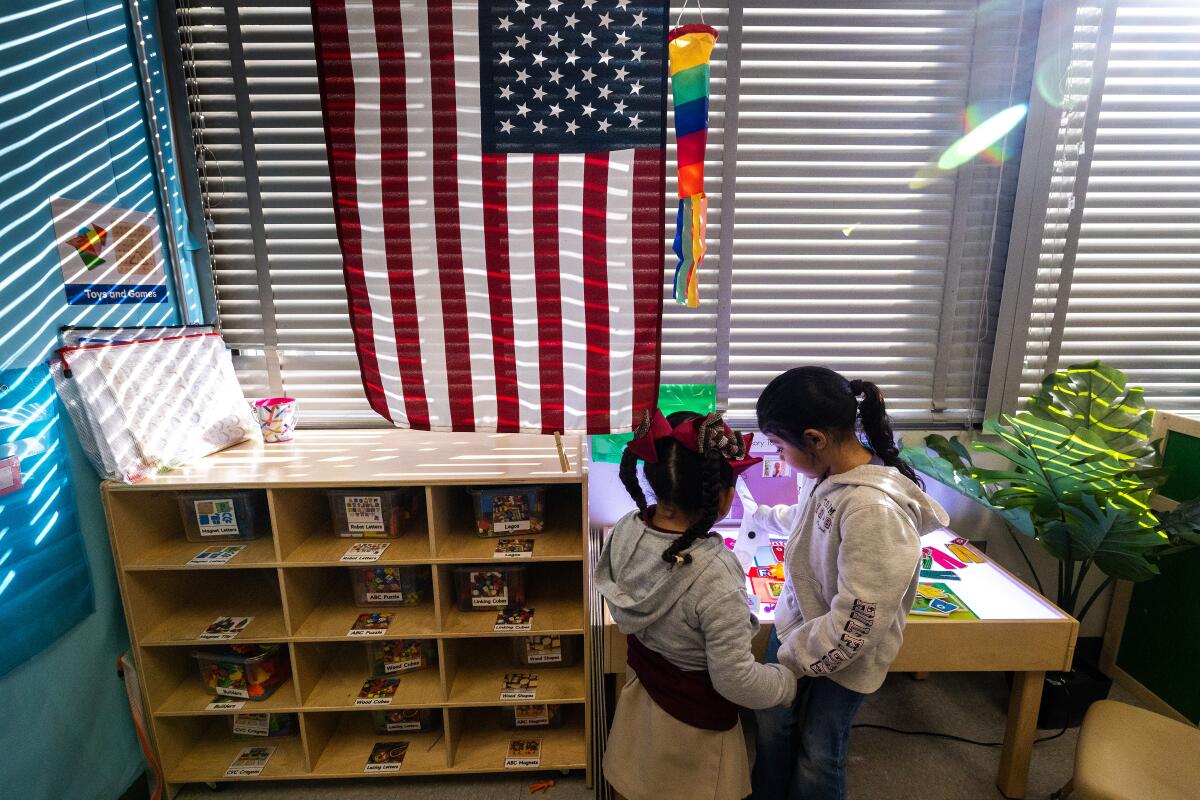California school enrollment continues to drop as poor and homeless student numbers rise

- Share via
- California public school enrollment continues a steady decline.
- This drop is putting financial pressures on school districts.
- The number of students from low-income and homeless families is going up.
California public school enrollment has declined for the seventh straight year and the number of students from low-income and homeless families has increased as many school districts throughout the state face financial pressures to downsize.
Statewide, perhaps the most stark figure is a comparison between enrollment in 12th grade — 488,295 students — and in 1st grade — 384,822. That’s a more than 20% difference between the size of the class leaving school and the size of the class beginning its trek through the public school system.
One encouraging note is the growing number of students in transitional kindergarten, a new grade that serves 4-year-olds.
Public school enrollment for the current school year, officially collected last fall but released Wednesday, totaled 5,806,221 students, a decrease of 31,469 students or .54% from the prior year, according to the California Department of Education.
“These losses largely reflect the fact that there are now substantially fewer school-age children in the state,” said Thomas Dee, a Stanford University education professor and economist. “This demographic decline is due to both lower birth rates and net migration of families with children out of California — e.g., due to housing costs and the growth of work-from-home employment.”
“The most striking aspect of these data is that the students who fled public schools at the beginning of the COVID-19 pandemic still have not returned,” Dee said.
The number of students from low-income families rose by nearly 1%, and there was a more than 9% increase in the number of students experiencing homelessness, according to the state education department.
Local school district challenges
The enrollment picture has varied greatly by region — with schools in some areas growing or maintaining as others shrink.
Los Angeles Unified enrollment has plummeted by nearly half in the past two decades, from 747,009 in 2003-04 to 387,152 in the current year. Since 2016-17, L.A. Unified enrollment has dropped nearly 30%.
Over that same period, the state decline was just under 7%.
Among the relatively small number of school districts that showed growth over roughly that same period are Elk Grove Unified in Sacramento County, Clovis Unified in Fresno County and Roseville City in Placer County.
Decreasing enrollment is challenging school systems up and down the state because it means they receive less revenue without a corresponding decrease in overhead and staffing costs. The enrollment drop has coincided with an end to federal pandemic aid and lower-than-anticipated state tax revenues that have resulted in cuts to programs and services.
The Board of Trustees of Santa Ana Unified on Monday, for example, voted to shed 262 jobs amid declining enrollment and a $154-million budget deficit. Officials described the layoffs as difficult but necessary as the enrollment decline is expected to continue.
In a budget presentation this week, Los Angeles Unified officials said they hope to avoid layoffs but will need to significantly reduce the number of employees over the next two years — including through such means as not replacing departing workers, reassigning employees to lower-paid or higher-priority jobs and closing out positions when they become vacant.
Over the past decade, the largest drops in statewide enrollment overlap substantially, but not entirely, with the COVID-19 pandemic. The largest single-year decline was the year prior to the pandemic, according to state data.
State officials noted that enrollment at private schools also was down from the previous year. Enrollment in charter schools was up, but not enough to account for the overall lower enrollment in traditional TK to grade 12 schools, officials said.
But Dee said the longer-term picture showed something different.
“The public school enrollment losses also reflect an enduring increase in private and home-school enrollment,” he said. “The combination of private and home-school enrollment is over 4% higher than it was at the beginning of the pandemic.”
Transitional kindergarten ramps up
Statewide, the enrollment drop over recent years occurred even as the state added a new grade level, transitional kindergarten or TK. The number of TK students grew 17%, from 151,491 to 177,570. The state extended the age range of 4-year-olds who can attend as part of a years-long ramp up, which likely accounts for much if not most of the enrollment rise. The new grade level will be open to all 4-year-olds for the first time starting in the fall.
While the number is growing, enrollment in transitional kindergarten is falling short of expectations. Gov. Gavin Newsom set an ambitious goal of 400,000 students enrolled in TK by the 2025-26 school year.
However, the governor decreased the line item for TK funding for next year by $300 million in the May revision of his proposed budget for 2025-26, due largely to a reduction in the state’s projected TK enrollment.
State Supt. of Public Instruction Tony Thurmond said the progress in TK is encouraging.
“While we have more work to do, the dramatic growth in TK is inspiring and shows that providing rigorous and quality programs can be a key ingredient to bringing more families back to our schools,” Thurmond said.
UC Berkeley education professor Bruce Fuller praised the governor’s “heartfelt ambitions” in authorizing state-funded transitional kindergarten, “but he’s falling short on implementation.”
It is also unclear how many of the children enrolling in TK are new to early education, and how many were already enrolled in other government-funded programs.
Enrollment in TK and kindergarten is not compulsory in California.
“It’s good news that another 26,000 California families are finding affordable preschool,” said Fuller, “but it remains unclear whether, overall, the preschool enrollment rate is going up statewide.”
About 43% of the state’s 4-year-olds are now enrolled in TK, based on state Department of Finance estimates.
More to Read
Sign up for Essential California
The most important California stories and recommendations in your inbox every morning.
You may occasionally receive promotional content from the Los Angeles Times.















